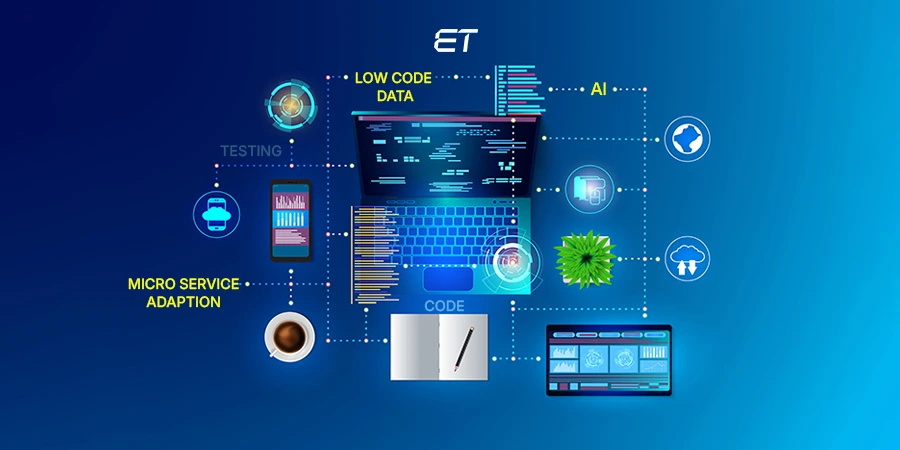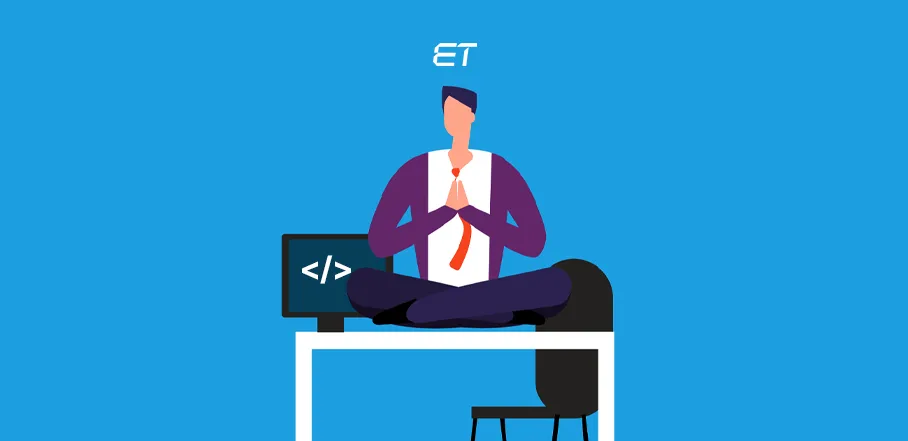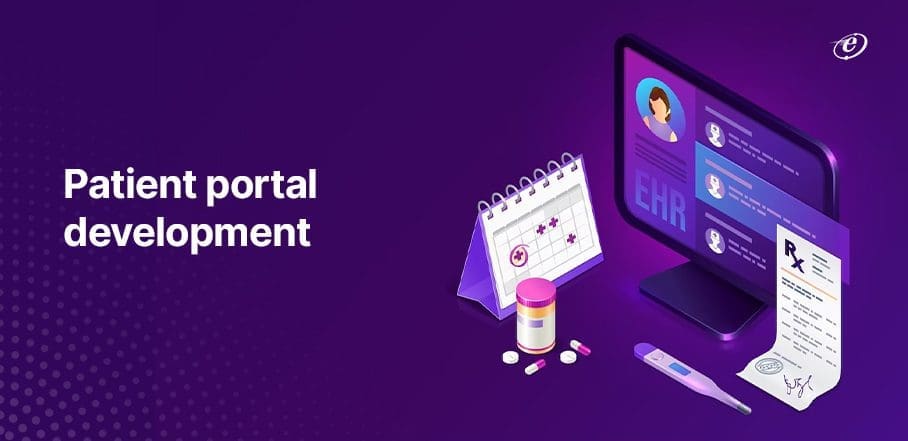
A Comprehensive Guide on Patient Portal Development
Adopting digital health solutions to transform care and treatment represents a seismic shift in the healthcare industry. One such change that has brought in a new era of patient participation in the healthcare sector is Patient Portal Development.
Patient portals are used to improve the care given to patients. Besides this, these portals allow doctors and patients to communicate more effectively. It improves the patient-physician bond and provides people with more control over their treatment.
Let’s evaluate these portals’ potential considering current market trends.
- Grand Research Report estimates that the worldwide patient portal market was worth USD 2.9 billion in 2022 and is projected to increase at a CAGR of 19.44% from 2023 to 2030.
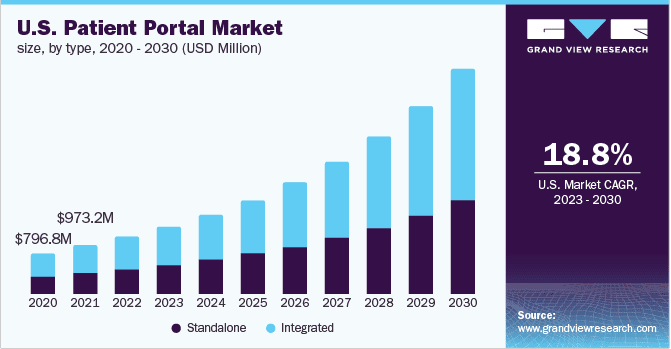
- The market for patient engagement solutions generated $17.3 billion in revenue in 2022 and is anticipated to increase to $27.9 billion by 2027, rising at a CAGR of 10% between 2022 and 2027.
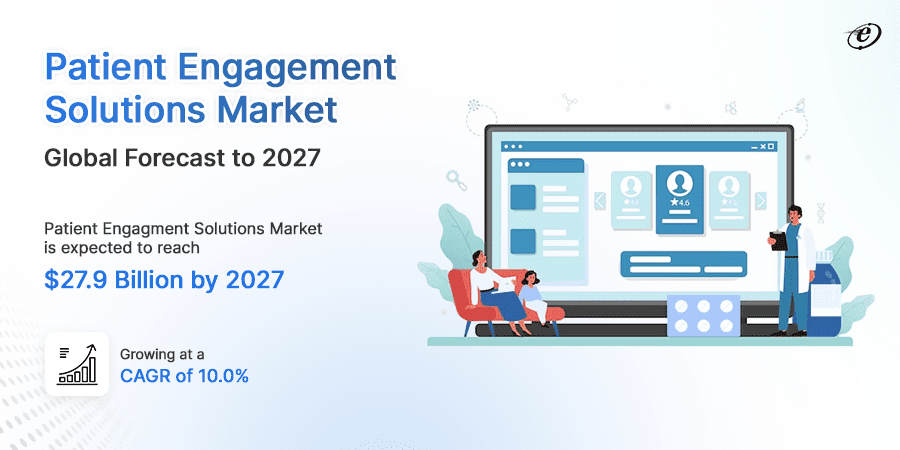
- The increase in the number of medical applications downloaded in January 2020 compared to the ‘peak’ month for the COVID-19 issue in each country is cited by Statista.

The telemedicine market has expanded considerably in recent years. The global telemedicine market was projected to be worth 50 billion dollars in 2019 and is predicted to be worth almost 460 billion dollars by 2030.

- According to Chime research, in 2021, 83% of acute care companies reported high user usage of patient portals, up from 74% in 2020.
The statistics shown above demonstrate how patient portals are transforming the healthcare sector. So, it’s a good time to look for a leading portal development company and get one for your healthcare services.
Read this blog first to acquire a thorough understanding of patient portal development. Without further ado, let’s get started.
What Are Patient Portals?

First, let’s define what portals are.
A portal is a web-based platform that collects information from several sources and presents it to users in a single user interface, allowing them to see the information most relevant to their circumstances. Many people confuse websites and web portals.
A quick comparison of them is provided below.
| Parameters | Portals | Websites |
| Purpose | Specialized gateways for specific content | Cover a broad range of online content |
| Audience | Target specific users or groups | Accessible to a wider audience |
| Content | Tailored content and services | Informational, commercial, or interactive |
| Personalization | Offer personalized user experiences | Limited personalization options |
| Examples | Educational portals, B2B portals, Patient Portals, etc. | Blogs, e-commerce sites, informational sites |
Read more on how web portals are different from websites.
Talking about Patient Portal, it is an online tool (web page or mobile app) that provides patients 24/7 access to their health and medical records, personal profiles, health billing management, and information about their past use of healthcare services.
A patient portal might be an integrated portal or a separate portal. It is a centralized system for managing transactions, keeping records, and providing services to all parties involved in healthcare, including patients.
Patient portals can cover various types of information to enhance communication and healthcare access for patients:
Information That Can Be Managed Through Patient Portals
| Personal Health Records (PHR) | Patients can access their medical history, medications, lab results, and immunization records. |
| Communication | Secure messaging with healthcare providers for non-urgent queries and follow-ups. |
| Appointment Management | Patients can schedule, reschedule, or cancel appointments online. |
| Prescription Refills | Request medication refills electronically. |
| Education Resources | Health information, educational materials, and preventive care resources. |
| Billing and Payments | Access to billing statements and payment options. |
| Test Result | Access to diagnostic test results and radiology reports. |
| Health Reminders | Notifications for upcoming appointments or screenings. |
| Care Plans | Information on treatment plans and care instructions. |
| Telehealth | Virtual consultations and remote monitoring options. |
Note* Verify that the portal development company you select is familiar with HIPAA regulations. Understanding the different types of patient portals and their functions is crucial before moving further with patient portal development.
Know About the Types of Patient Portals

-
Integrated Patient Portals
For integrating healthcare systems like telemedicine, RPM (remote patient monitoring), and EHR/EMR (electronic health records), integrated patient portals are developed by portal development companies.
The main benefit of these portals is medical practice becomes more efficient as money is saved on creating a gateway with healthcare systems. These kinds of patient portal systems have more significant development costs since they take longer and more work to plan and implement.
An example of integrated patient portal is athenahealth.
-
Standalone Patient Portal
Standalone sites do not have a direct connection to EHR platforms. These portals can be connected to EHR data from one clinic or many different providers. Because a more straightforward software architecture powers a standalone patient portal development, it requires less time and money.
These patient portals are a common feature of commercial health plans, including access to invoices and claims, benefit details, and educational resources. Healthcare facilities, health insurance providers, or employers may oversee these.
An example of standalone patient portal software is Solutionreach.
Benefits of Patient Portal Development for Health Providers & Patients
Patient portals are useful healthcare IT solutions that give people access to their medical records while also providing healthcare practitioners with a number of benefits. Patient portals’ primary goal is to improve communication between patients and healthcare professionals.
But what particular benefits does the software guarantee? Let’s cover all of them.

1. Self- Scheduling Appointments
-
Patient
Since online appointment scheduling can boost patient satisfaction and loyalty, it has become a primary focus for patients. Additionally, it improves call transfers and wait times, making it simpler to find same-day or next-day appointment availability.
Patients can now self-schedule appointments through a patient portal, which is used by many health organizations like UCSF Health. This ensures that patients receive the required attention without standing in line or getting impatient with lengthy wait times.
-
Healthcare Provider
With patient portal development, healthcare providers can set out a time slot for self-scheduled appointments. This results in their front and back-office support staff will have a better understanding of when they can take care of other elements of the practice. Additionally, it provides the staff with a precise image of the available blocks for each day, preventing conflicts with already scheduled appointments.
2. Access to Medical Records
-
Patient
Patients can easily view their medical records online through a patient portal. A study published in the journal Health Services Research found that the patient portal can increase medication adherence and decrease emergency room visits. It is also easier to find errors in an electronic medical record and avoid any calamity.
-
Healthcare Provider
A doctor can treat a patient properly regardless of their location because of simple access to medical records. All patients, particularly those with chronic illnesses or who have trouble scheduling appointments or contacting their doctors, can benefit significantly from patient portal development. It not just expedites payment processing, lab results retrieval, and prescription requests, but it also conserves time and money in other ways.
3. Greater Focus on Patient Care
-
Patient
Patients who can access patient portal claim to be happier with their overall treatment experience, and research shows that the technology can cut down on in-person visits. These healthcare IT solutions provide a one-stop shop for appointment scheduling, ordering prescription drug refills, and reminding patients what has to be done and when.
The patient is better positioned to comprehend what is happening in his body because he has access to the health record, which is the biggest benefit.
-
Healthcare Provider
Patient portals increase the patient-centeredness of healthcare and empower patients to manage their health. This experience may help keep more patients and bring in new ones. Patients are more engaged and satisfied when they can obtain consultation and medical information while sitting in their homes.
Additionally, the portal’s payment gateway ensures that services are paid for quickly and easily. Healthcare providers can also educate patients with medical articles weekly/monthly published on portals.
4. Support for Telemedicine
-
Patient
Patients frequently find that some medications don’t work for them and need to see a doctor only to change medications. Not only does it waste time, but more significantly, it hinders the patient’s rehabilitation. With the portal, patients may simply arrange appointments online to chat with the doctor rather than making a physical appointment.
-
Healthcare Provider
Using a patient portal, medical services providers can reduce the number of unneeded patient visits to your clinic. Patients can communicate with you through the message system for a few unimportant doubts at any time. For instance, patients are not required to see a doctor just to change their drug dosage.
5. Improved Communication
-
Patient
With these portals, patients may now talk with doctors wherever they are, at any time. Communication between a patient and his doctor is improved via a patient portal. The portal enables real-time communication between the patient and doctor by enabling video calls or text messages. Patients can use these systems to view doctor appointments, get test results, ask for medicine refills, or talk about any medical issues.
-
Healthcare Provider
The IT strategy of every healthcare institution continues to be fundamentally dependent on patient portals. This is due to their many benefits, including lower administrative costs, improved patient involvement, better health outcomes, and better communication.
Additionally, these portals offer doctors a view into their patients’ health, enabling them to make better decisions about their care. For example, in an emergency, if the patient has a seizure or is about to give birth. This situation is immediately shared with the doctor so they can act quickly.
6. Better Epidemiologic Safety
-
Patient
To ensure epidemiologic safety, healthcare IT solutions like patient portal software assist patients in managing their issues online. They may monitor their heart rate, blood pressure, oxygen level, and a variety of other metrics from the comfort of their home. Patients who are very young or elderly will notably benefit from this.
-
Healthcare Providers
Hospitals, medical facilities, and pharmacies can better manage the danger of contagious infections (not just COVID-19 but also conventional flu and many more) because of a drop in foot traffic.
You might find the report below interesting!
There was a significant change in patient portal adoption due to the emergence of COVID-19 pandemic.
Why should healthcare providers choose patient portal development?
Do you want to know how developing portals help the healthcare industry stand ahead of competitors? Yes, then keep reading!

-
Minimizing Errors
Inaccurate diagnoses, incorrect prescriptions, and occasionally fatalities can result from errors in the documentation of patient medical information. Patient portal software decreases human error by automating administrative and management duties involving medical data. These portals gather all data in one location to guarantee the correctness of records. When two pieces of information clash, the system flags the mistake for fixing.
-
Time-Saving
Front-desk employees’ workload reduces when patients are introduced to self-service via online portals. During busy times, fewer low-priority calls or other non-urgent communications are taking up front desk time, which can be invested in more critical or urgent calls. This boosts employee productivity, freeing them to work on other crucial projects.
-
Increased Efficiency
Patient portal development enhances work efficiency by making patient communication simpler. For instance, because patients may provide their information electronically, procedures like signing up new clients are made simple. You do not need to maintain records manually, because data is saved digitally. You won’t need to ask the same questions over and over since the information is readily available. Additionally, this lessens informational inaccuracies and inconsistencies.
-
Lower Cost
For healthcare providers, patient portals are economical for several reasons. They simplify administrative processes, resulting in less paperwork and less effort for workers. You may enhance many other manual operations by adding a digital channel, such as a payment gateway, telemedicine, etc. Patient portals improve productivity, patient happiness, and resource use overall, saving healthcare providers money.
-
Streamline Workflow
Without these portals, nurses and receptionists must plan in-person appointments while receiving calls from multiple patients at once. Similar efforts are made by lab scientists to mail out test results to a lot of patients.
Healthcare providers streamline workflow with patient portals by enabling online appointment scheduling, secure communication with patients, access to medical records, prescription refills, remote monitoring, online bill payment, patient education, and e-consultations.
You must have been astounded after reading all of these patient portal benefits?
If you are choosing patient portal development as your next step in expanding your healthcare business, find out the vital components of a patient portal in the next section.
10 Essential Features in Your Patient Portal
While creating any web portal, we need to understand a number of things. Patient portals must be designed more carefully, considering the needs of patients and healthcare practitioners.
A thoughtful selection must be made. Therefore, determine what functionalities you want in your site with the assistance of a custom healthcare software development company. A feature guide is provided below that will help you:

1. Patient Self Registration
It’s imperative to offer a simple sign-in and registration process. The patient can self-register on the portal and fill out a thorough medical history form, including details on allergies, ongoing treatments, and medications.
Better care and treatment are made possible by an accurate and comprehensive record. Keep in mind that registration must be both quick and safe. A problematic process may quickly turn patients away.

2. Patient Dashboard
The patient’s dashboard, personal space, is the next crucial component in patient portal development. The patient’s contact details, medical history, test results, appointments, advice, and payment history can all be accessible here. Besides this, patients can find information regarding allergies, medical problems, and diagnoses.

3. Physician Profile
This feature includes all the details regarding physicians, their work experience, education, specialties, etc. Patients can look through the directory and pick the doctor who will best address their issue.
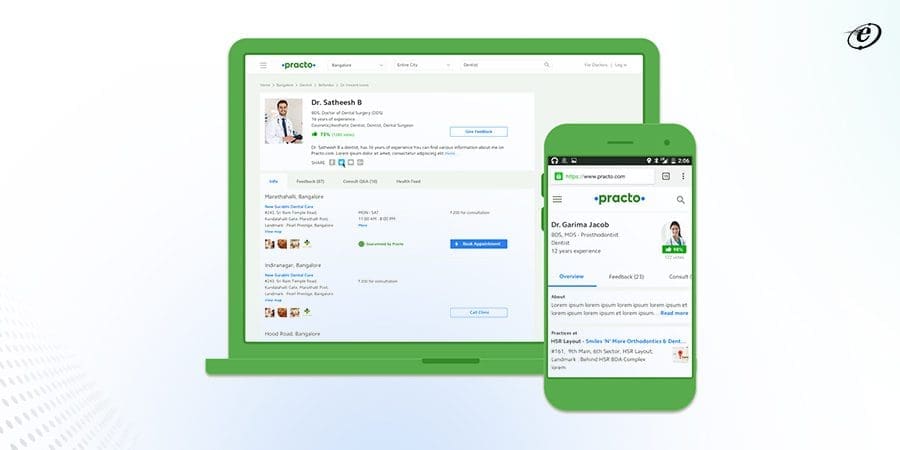
4. Online Appointment Booking
Another essential feature of the patient portals is online appointment scheduling. Patients can schedule appointments at any time, irrespective of their location. You can include a calendar feature that notifies the patient of upcoming appointments and sends an email or SMS confirmations.
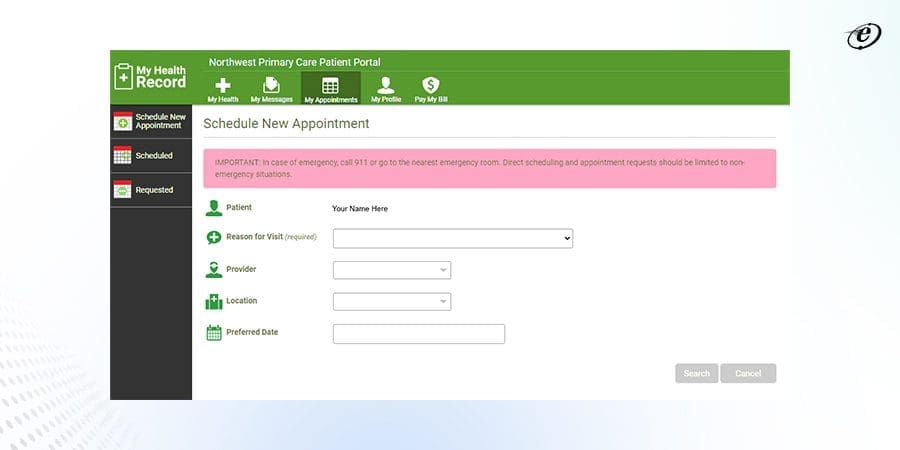
5. Prescription Management
Tele-medication functionality is a need for your patient portal. Patients frequently need access to prescription refills due to their ongoing treatment and frequent medical procedures. This function is beneficial for older people who occasionally cannot travel to the hospital. The patient portal assists by collaborating with nearby pharmacies to provide medications to the patient promptly. Professionals may expect an increase in patients by enabling this process.

6. Payment Gateway
The ability to make payments and view payment history is one of the most crucial elements of patient portals. Payment gateways on the patient portal make it simple and quick to settle invoices so that healthcare is accessible quickly and conveniently. Moreover, patients can check their previous payment records easily.

7. Chats & Chatbots
Personalized assistance or consultation via encrypted chat is a must-include feature in your patient portal development. This tool can serve as a path for patients to quickly consult with or receive clarification from their doctor or any of their staff members, such as nurses or healthcare assistants.
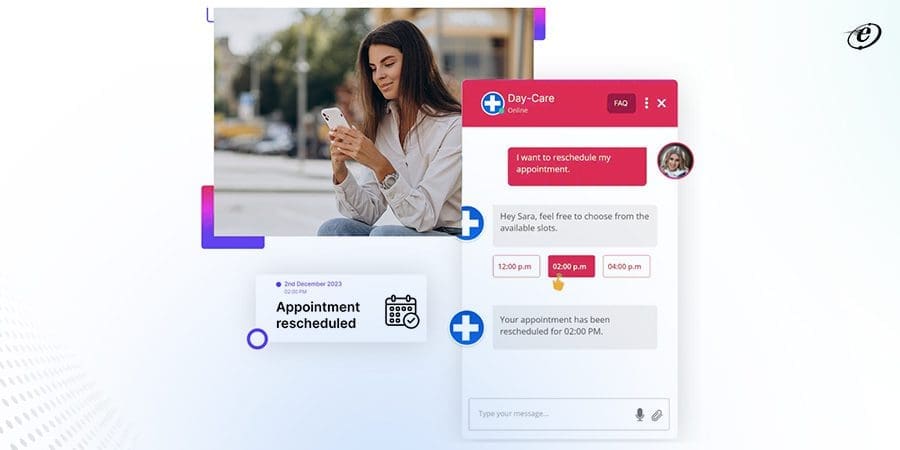
8. Notification
Patients typically need to follow a regular treatment plan, including diet, exercise, prescription medication, therapy, or counseling. These notifications remind patients of ongoing treatment. Besides this, Patients can use this service to receive notifications and reminders for appointments, required tests, report pickup, etc.
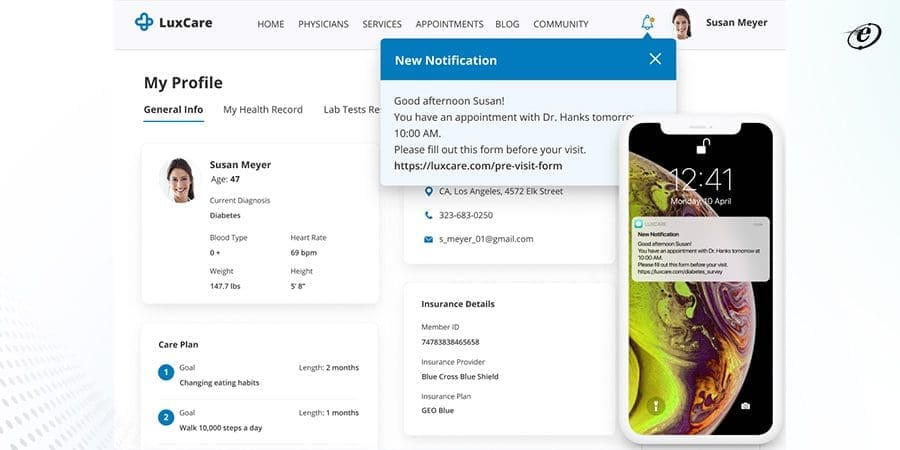
9. News & Education
Portals can include a variety of wellness/fitness advice, videos, and articles on topics connected to health that foster a better awareness of illnesses and their treatments.
These resources support the patient’s knowledge of his condition and ability to administer Do-It-Yourself care before seeking medical attention. Most importantly, patients can remain engaged when they have access to recommended health information that is pertinent to them.
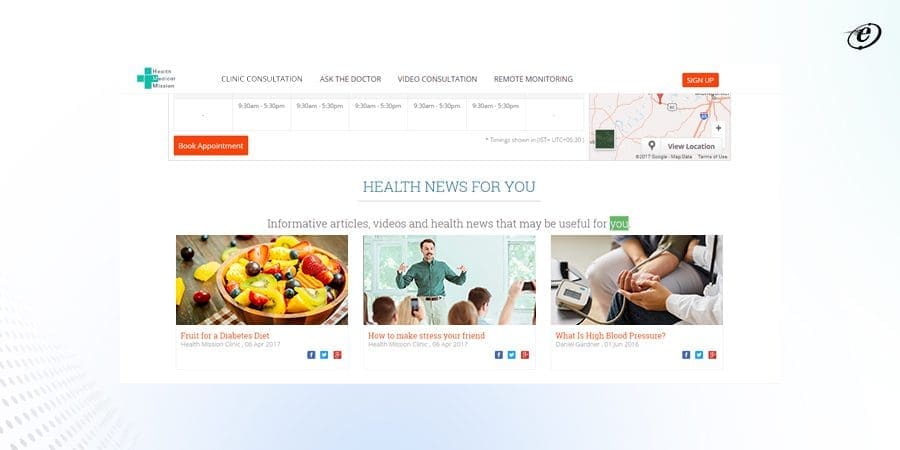
10. Third-Party Integration
A patient portal must offer third-party integration, enabling seamless connectivity with external healthcare systems. Consider connecting systems like EHR, glucose monitors, telehealth apps, fitness trackers, and more to get the most out of the patient portal.
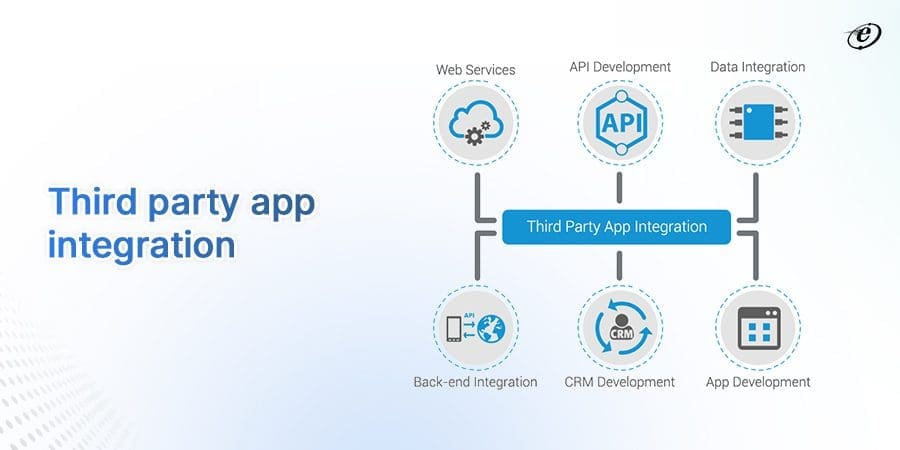
In addition to these features, adhering to HIPAA regulations is one of the most important steps in patient portal development. Visit our blog, A Beginner’s Guide on HIPAA-Compliant App Development.
Now it’s time to go over how a portal is developed by portal development companies.
Step-By-Step Procedure of Patient Portal Development
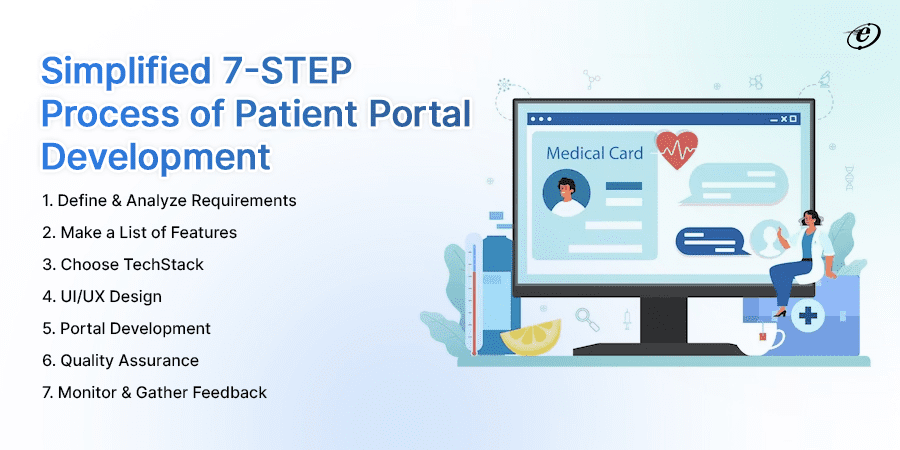
Patient portal development requires careful planning, design, and implementation. Here’s a step-by-step procedure to guide you through the process:
1. Define & Analyze Requirements
- Specify the patient portal’s objectives and scope in detail.
- Work with healthcare professionals, patients, and other stakeholders to gather requirements.
- Recognize their requirements, expectations, and problems by trying to solve them through the portal.
- Conduct surveys and interviews to ensure you cater to your target audience’s demands.
2. Make a List of Features
- Decide which specific features and functions you wish to have, such as appointment scheduling, access to patient information, requests for medication refills, secure communications, and interaction with other healthcare systems.
- Make two lists: one of essential features and the second of not-so-urgent features.
- You can start by adding the most important elements to your portal based on your time or budget, and as it succeeds, you can add more features.
3. Choose TechStack
- Select appropriate technology and frameworks to build the patient portal.
- Consider scalability, security, interoperability, and compatibility with existing healthcare systems.
- Ensure that the chosen technology complies with relevant healthcare regulations and standards.
- Some of the most popular front end technologies in 2023 are AngularJS, ReactJS, and VueJS.
4. UI/UX Design
- Create a visually appealing and intuitive UI/UX design that enhances the overall user experience.
- Ensure the portal is easy to navigate and offers a seamless user journey across devices like desktops, tablets, and smartphones.
- Understand the significance of responsive design in portal development.
5. Portal Development
- Develop the core features of the patient portal, including patient registration, appointment scheduling, access to lab results, medical history and secure messaging with healthcare providers.
- Prioritize the essential features first, then progressively increase the portal’s capabilities.
- Build a robust back-end infrastructure to handle data storage, security, and integration with various healthcare systems.
- Protect sensitive patient information by implementing appropriate data encryption and access controls.
6. Quality Assurance
Do thorough testing to find and fix bugs, usability problems, or security risks.
Test the portal’s functionality, performance, and security to confirm reliability.
Involve a small group of users to participate in user acceptance testing (UAT). Gather feedback and make necessary improvements based on their input.
7. Monitor & Gather Feedback
- Following the launch, keep an eye on the patient portal’s functionality and usage.
- Obtain customer input to comprehend their experiences and spot any areas needing improvement.
- Analyze user data frequently to learn about user preferences and behavior.
By following this comprehensive step-by-step procedure, you can develop a patient portal that enhances patient engagement, improves healthcare outcomes, and strengthens communication between patients and healthcare providers.
Successful Patient Portal Development: Tips From Experts
As a leading web portal development company, we have developed portals for various clients worldwide. Sharing a few of our tried and tested tips
- Put user experience first and adopt a user-centered design process when creating the portal. Conduct user research and engage with patients and healthcare providers to understand their needs, pain points, and preferences.
- Ensure the portal connects to different EHR (electronic health record) systems and other medical applications. The portal and other systems must efficiently share data to provide complete patient information.
- Put a strong emphasis on privacy and security measures to safeguard sensitive patient data. Implement two-factor authentication, encryption, and regular security audits to protect the site from potential attackers.
- Many users prefer using their smartphones or tablets to access healthcare information and services, making the patient portal mobile friendly.
- Before deploying the portal, give it a thorough test run to find and fix any problems. Gather feedback from beta users and stakeholders to make necessary improvements.
- Enable safe communication between patients and medical professionals. This makes it easy for patients to ask inquiries, get guidance, or ask for prescription refills.
- Start with quick prototyping to save the development budget on features that are not necessary or are done incorrectly. You can deliver a product with the best product-market fit by using a rapid prototype in conjunction with an agile software development methodology.
Find the Cost of Patient Portal Development
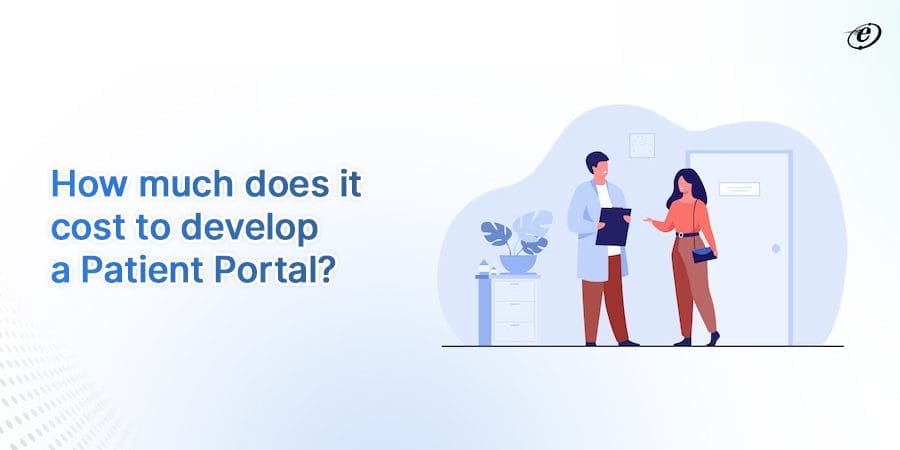
The average cost of patient portal development is between $80,000 to $300,000+. The price varies depending on factors, including the development team, the technical resources employed and integrated, and the time spent creating the patient portal software. Custom patient portal development can also have a big impact on cost.
The cost of developing a patient portal is on the higher side for businesses in the US. In the USA, a front-end developer can earn up to $90K annually.
Find the Telemedicine App Development Cost.
But, you can significantly reduce prices by engaging with professionals outside of the United States for IT development. The portal can be prepared for less than $100,000 if you go with outsourcing or offshoring.
Here is a cost-wise distribution of development teams in different regions
Patient Portal Development (Hourly Rate) in Different Regions
| Development Team | South Asia | Southeast Asia | Latin America | North America | Central & Eastern Europe |
| Project Manager | $35-$65 | $30-$60 | $50-$80 | $60-$160 | $40-$80 |
| Architect | $40-$80 | $45-$65 | $60-$95 | $90-$200 | $60-$100 |
| Business Analyst | $35-$60 | $35-$65 | $35-$50 | $75-$150 | $35-$80 |
| Graphic Designer | $25-$40 | $30-$35 | $40-$80 | $90-$125 | $35-$100 |
| DevOps | $35-$55 | $40-$55 | $50-$100 | $80-$150 | $50-$90 |
| Lead Developer | $40-$65 | $35-$50 | $60-$100 | $35-$65 | $80-$200 |
| Junior Developer | $25-$40 | $25-$35 | $35-$65 | $80-$150 | $25-$65 |
| QA Engineer | $30-$45 | $25-$35 | $40-$75 | $60-$120 | $40-$70 |
| Scrum Master | $35-$65 | $40-$60 | $45-$85 | $80-$150 | $45-$75 |
Final Words
During the pandemic, healthcare IT solutions were essential. However, people and healthcare professionals still favor it even after the pandemic. This is obviously due to the undeniable benefits like easy appointment scheduling, effective communication, the ability to talk and advise patients at any time from any place, and many more.
Today’s scene is that every new and old healthcare provider chooses patient portals to increase efficiency and streamline workflow. So competition in the healthcare industry is increasing with these healthcare IT Solutions.
Now patient portal development is not a need but an essential step toward the growth of your healthcare business. Hiring an experienced web portal development company will be a great helping hand to achieve your goals.
eLuminous Technologies is a leading custom web portal development company in India, the USA, the UK, and Australia. We can customize your portal in accordance with your specifications and predetermined budget. Our web portal development team is an expert in patient portal development that adheres to HIPAA regulations.
Hurry up! Book your free consultation!
Frequently Asked Question
What is HIPAA-Compliant Law?
HIPAA stands for Health Insurance Portability and Accountability Act). It is a US law ensuring the privacy and security of individuals’ protected health information (PHI) by healthcare providers and organizations. It mandates strict standards, safeguards, and penalties for any unauthorized disclosure or mishandling of PHI (Patient Health Information)
What is the difference between a portal and a website?
A portal is a specialized website that allows access to various resources and services, often from multiple sources. It serves as a centralized platform for specific information or functions. Conversely, a website refers to a general collection of online pages accessible through a single domain.
How can I make my portals easy to use for any patient?
There are few points you need to consider in your patient portal development,
If you want to make portals easy to use for any patient. Those are:
- Focus on intuitive design, clear instructions, mobile responsiveness, accessible language, and minimal steps.
- Conduct user testing to identify issues and provide a feedback mechanism.
- Prioritize security and offer video tutorials for visual learners, ensuring a user-friendly experience for all patients.
Understand with our web portal development team how to make the patient portal user-friendly

